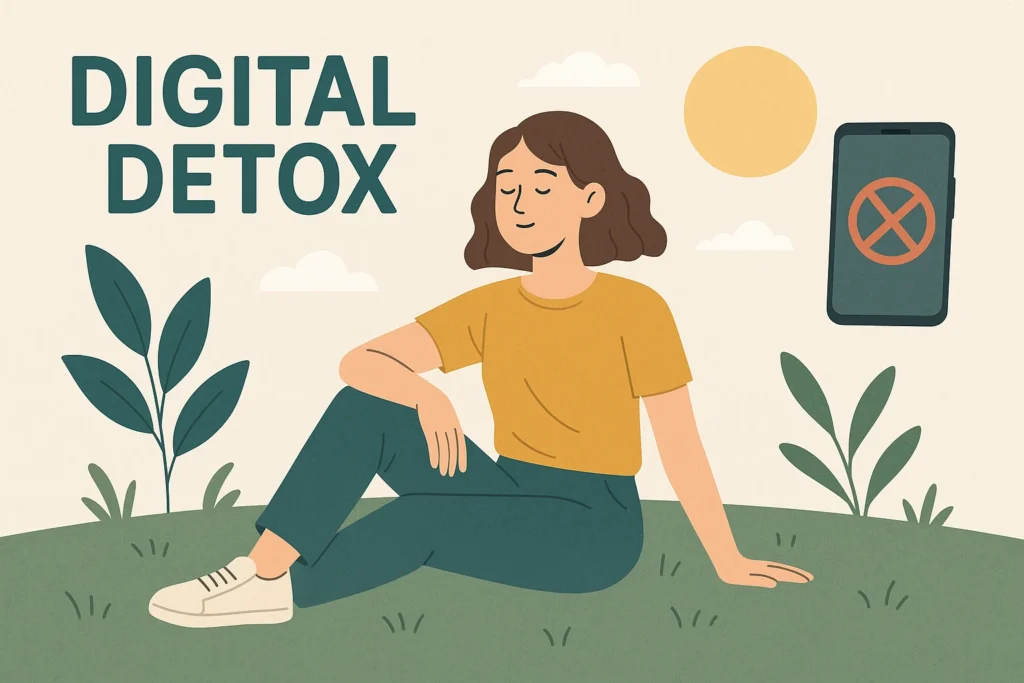The Moment Everything Changed
Sarah’s hands shook as she stared at her locked smartphone screen. The notification read: “Screen Time Report: 11 hours 47 minutes today.” It was 11:52 PM, and she realized with horror that she’d spent nearly half her waking life staring at this glowing rectangle—scrolling past ads she didn’t remember, liking posts that left her empty, and consuming content that evaporated from her mind like morning mist. That night, Sarah made a radical decision that would change her life: she declared war on her digital addiction.
Chapter 1: The Digital Pandemic – Why We’re All Suffering
The Shocking Numbers
- Average screen time: 6h 58m daily (2024) – more than we sleep
- Phone checks: 144/day (every 6.5 minutes)
- Brain impact: Digital stimulation triggers 2x more dopamine than food
A Day in the Life:
| Time | Digital Activity | Equivalent Analog Activity |
|---|---|---|
| 7 AM | Scrolling news | Reading newspaper (20 min) |
| 9 AM | Zoom meetings | In-person discussion |
| 12 PM | Social media lunch | Observing nature |
| 8 PM | Streaming shows | Reading novel |
“We’ve become the first civilization in history that pays more attention to artificial worlds than real ones.”
– Dr. Elena Markova, Neuroscientist
Chapter 2: The Body Keeps the Score – Physical Toll of Screens
Silent Symptoms You’re Ignoring
- Tech neck: Head weighs 27 lbs at 45° angle (normal: 10-12 lbs)
- Digital eye strain: 65% of office workers suffer daily
- Text claw: New form of repetitive stress injury
Case Study: After 3 months without gaming, 17-year-old Mark’s chronic migraines disappeared
Chapter 3: The Mental Health Crisis in Your Pocket
How Phones Rewire Brains
- Attention fragmentation: 40% worse focus than goldfish (Microsoft study)
- Memory erosion: We forget 80% of digital content within 3 days
- Anxiety loops: Notifications trigger cortisol spikes
Real Experiment: 300 participants who deleted social media reported:
✓ 37% less anxiety
✓ 29% better sleep
✓ 42% more face-to-face interactions
Chapter 4: Digital Detox Strategies That Actually Work
The 30-Day Reset Plan
Week 1: Delete all non-essential apps
Week 2: Implement “sacred hours” (no screens after 8 PM)
Week 3: Rediscover analog hobbies (cooking, journaling)
Week 4: Tech-free weekends
Pro Tip: Grayscale mode reduces phone appeal by 53% (University of Texas)
Workplace Solutions
- Email curfews: No sending between 7 PM – 7 AM
- Meeting-free Wednesdays
- Desktop-only Slack policy
Chapter 5: The Joy of Missing Out (JOMO)
Rediscovering the Analog World
- Library renaissance: Print book sales up 18% among millennials
- Board game cafes: 4,200+ opened worldwide since 2020
- Handwritten letters: 300% increase in fountain pen sales
Sarah’s Transformation: After 90 days offline, she:
- Read 14 books (vs. 0 previously)
- Learned pottery
- Had 3x more meaningful conversations
Chapter 6: Raising Screen-Smart Kids
The Silicon Valley Paradox
- 73% of tech executives limit their children’s screen time
- Waldorf schools (no tech until high school) have 40% higher college acceptance
Healthy Limits:
- Under 2: Zero screens
- 2-5: 1 hour educational content
- Teens: No devices in bedrooms
Epilogue: Finding Balance in the Digital Age
As Sarah sits in her garden watching real birds instead of Twitter’s logo, she realizes digital minimalism isn’t about rejection—it’s about reclamation. The apps haven’t disappeared; they’ve been demoted from masters to tools. Her phone now lives in a drawer for hours, not her hand. The notifications still come, but they no longer dictate her life’s rhythm.
In this quiet space between pings, she’s rediscovered something revolutionary: her own uninterrupted thoughts. And that, in our hyperconnected world, may be the most radical act of all. The challenge isn’t to abandon technology, but to bend it to our humanity—before it bends us.



